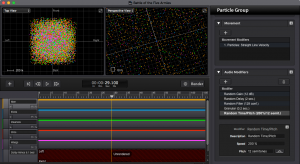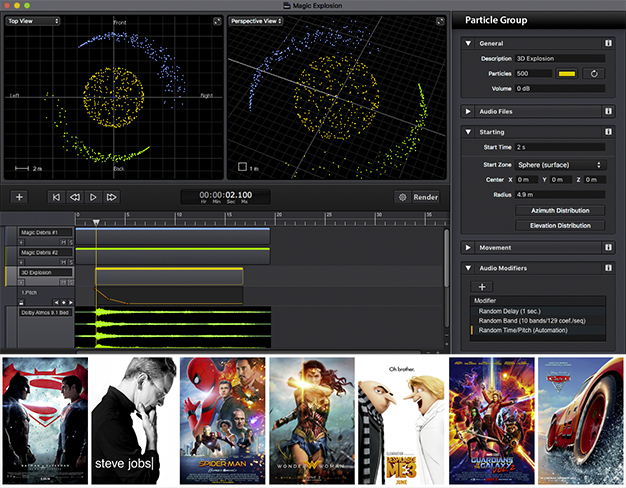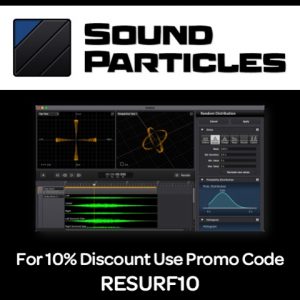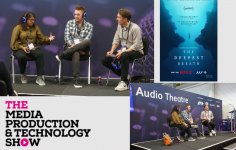Picture the scene
… Any scene. The more complex the better. The sort of scene where, from a tracklay point of view, it’s often difficult to contemplate where to even start.
Ever had a fantastic sound design idea and just not had the time to explore it in practice? Wanted to experiment with placing a mic, of any configuration, in the middle of any conceivable soundscape? Experiment and tweak. Then have the resulting files created in stereo, 5.1 or an immersive format?
All of the above has been made possible, virtually speaking, through the application of particle systems to the world of audio by Sound Particles: a new, simple software application. Already in use on a number of major feature films, but at a price point for pretty much everyone. Read on to learn more and receive an exclusive Resurface discount offer on this unique VFX-style audio toolset.
What are Particle Systems?

The world of on-screen entertainment has constantly pushed technical boundaries to give audiences the most believable experience possible. It’s fair to say that the use of particle systems in CGI is one of the biggest contributors to making visual fiction feel like reality. Originating in early 80’s sci-fi and now a well-established and widely used technique for our colleagues in VFX, particle systems allow the creator to employ any number of individual graphic objects to simulate certain kinds of natural, chaotic or “fuzzy” phenomena. Cameras and light sources can be positioned and moved relative to objects in a 3D space, creating ‘the shot’ to be rendered.
Common examples – the quality of which we’ve seen improve drastically in a decade or two – would be fire, rain, crowds, explosions, moving water, hair and fur.
Prior to the advent of particle systems, this stuff just couldn’t be done – or, looking back, at least not very well.
The notion that tens, often millions, of individual elements of a scene would be copied, pasted, and individually animated with just the right amount of random behaviour is, of course, crazy. Not to mention it’s a budgetary non-starter. All of this wonder is made possible, viable, by particle systems.
What about Audio?
Given this isn’t a new creative methodology, why not apply that same, standard VFX workflow and toolset – but for audio? Seems obvious, yet until now has never found its way into a readily available audio application. This was the thought process followed by Nuno Fonseca, creator of Sound Particles.
Having had the idea prior to completing his PhD (incidentally centred on the topic of re-synthesis of the human singing voice), Nuno decided to apply his learning to building an application that brings the creative power of particle systems into the hands of sound designers everywhere. In simple terms, the Sound Particles application substitutes graphical elements with sound sources and cameras with microphones, while keeping the particle workflow the same. Much like the VFX technique, the chaotic and random attributes that give an effect a natural feel are here too.
If you’re like us then you’re already thinking that this could be fun. You’re already considering the possibilities. Complex at times, perhaps a bit science-y in places, but the time saving and creativity possibilities are incredibly powerful.
Particles in practice

So let’s simplify it using a practical example. Something painstaking and time-consuming to tracklay – a battle scene: The shot calls for the sound of five thousand soldiers, doing what five thousand soldiers do, spread over a square mile. Oh, and the camera is moving. And you’re working in Dolby Atmos.
Using Sound Particles, you would pick (say) 50 war-related sound effects from your library. Set the number of particles (sound sources) to 5000, spread randomly over a space of 1 mile x 1 mile.
Sound Particles will pick (again, randomly) from your predefined set of SFX for each of the 5000 particles. Some triggering audio file 1, others audio file 2 and so on.

To add realism to the naturally chaotic sound of war, you would add movement modifiers and audio modifiers. As the names suggest, movement modifiers add movement to each of the particles. Audio modifiers apply random effects to the particles such as gain, delay, EQ or time/pitch variations.
To capture the sound of the scene, drop a virtual microphone into position. The mic can be whichever format you’re working in: 9.1 in this example. The scene is then captured and rendered out to files based on the position of the microphone, and its direction and movement relative to the particles, taking into account factors such as the speed of sound and doppler effect.
Trial version and Discount Code
There’s something about putting all of this into words on a screen that feels like it’s sucking all the joy out of it! The best thing to do is try it out for yourself, which you can do for free by downloading a fully-featured trial. Download begins when you click here
Sound particles isn’t a plugin, it’s a DAW-agnostic standalone app for MacOS which sells for $299. If you’re interested in buying a copy and would like to save 10%, then the good news is that you can use the code RESURF10 at their online store to qualify for the discount. Simply enter the code in the ‘discount code‘ field (NB: not the voucher field)




